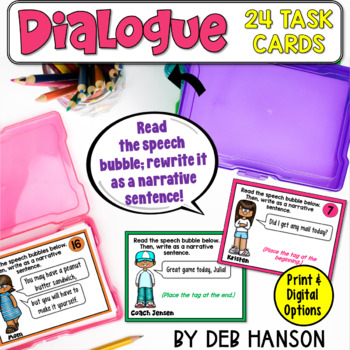Dialogue Task Cards: Practice Writing Sentences with Quotation Marks 3rd 4th 5th
- Zip
- Google Apps™
- Easel Activity

What educators are saying
Also included in
- Do you students misuse quotation marks when trying to add dialogue to their stories? Would you like to teach them the punctuation rules for writing with dialogue? If so, this bundle contains a variety of activities that should help you achieve your goal.This dialogue bundle has everything you need tPrice $8.50Original Price $10.99Save $2.49
Learning Objective
Students will punctuate dialogue using quotation marks, commas, and tags appropriately.
Description
Writing Dialogue Task Cards: This set of 24 task cards is designed to give your upper elementary students an opportunity to practice writing dialogue in narrative form. Students will read the speech bubble on the task card, and then rewrite the message as they would see it in a story, with quotation marks, commas, and speaker tags. Students must alternate between placing the tag before the dialogue, after the dialogue, or in the middle of the dialogue. (When two speech bubbles appear on one card, students are required to place the tag in the middle of the sentence or paragraph.)
The directions on each of the 24 dialogue task cards are always the same. They say: Read the speech bubble below. Then, write it as a narrative sentence. Therefore, students will complete the following steps as they work through each task card:
- They read and study the task card. Each task card has an image of a person with a name under the image. There is 1 or 2 speech bubbles near the person's face. When there is just one speech bubble displayed, there is also a direction at the bottom of the task card that states whether the tag should be placed at the beginning or at the end of the sentence.
- They rewrite the message in narrative form on their recording sheet.
- They check their sentence to make sure they placed commas and quotation marks in the correct places.
Many teachers report posting the task cards around the room to give their students an opportunity to get up and walk around the room as they complete the activity. Others say that they use these in a whole class activity where they place a task card under their doc cam, and then have students write the sentences on whiteboards. both activities provide an engaging alternative to a traditional worksheet activity!
Check out the preview!
********This resource is available in THREE formats:
- Traditional Printables- Print the PDF and distribute paper copies to your students to complete.
- Digital Version- This set of task cards utilizes Google Slides. There is one task card per slide (24 slides in all).
- Digital Version- This set of task cards utilizes an Easel Activity. There is one task card per slide (24 slides in all).
Here's what teachers like you had to say about using these task cards with their students:
⭐️ Erine A. said, "This was a fun activity for the kids to work on in class. I put the cards around the room and had kids complete a few a day. They enjoyed getting out of their seats and completing all the tasks."
⭐️ Claire K. said, "I love the open-ended opportunities for these task cards! They are great for practice and formative assessment! I usually have the kids write their sentences on whiteboards. I love to see them use a variety of tags—I always start teaching dialogue with a list of words better than “said.” This resource is a great way to practice dialogue authentically!"
⭐️ Karen S. said, "Great dialogue practice. I purchased them last year and used them again this year. It was a fun way to get them to punctuate dialogue correctly."
⭐️ Anna F. said, "My students enjoyed that the speech bubbles on the cards were in groups that related to each other. It really is little details like this that make resources stand out! We all enjoyed this activity for practicing dialogue. I also was able to clearly see my student's understanding of punctuating dialogue."
If you are looking for additional dialogue activities, feel free to check out my other dialogue resources:
Quotation Marks Worksheet (FREE)
Copyright by Deb Hanson
This item is a paid digital download from my TpT store
www.teacherspayteachers.com/Store/Deb-Hanson
This product is to be used by the original downloader only. Copying for more than one teacher is prohibited. This item is also bound by copyright laws. Redistributing, editing, selling, or posting this item (or any part thereof) on an Internet site that is not password protected are all strictly prohibited without first gaining permission from the author. Violations are subject to the penalties of the Digital Millennium Copyright Act. Please contact me if you wish to be granted special permissions!







